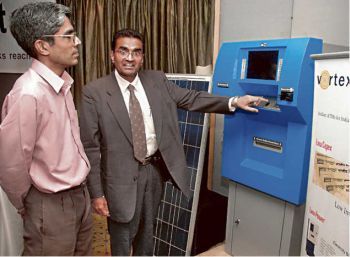Alternative energy can be a boon for third world countries. Normally governments have to invest vast sums of money in developing infrastructures for a long period of time in underdeveloped areas. If we consider the example of cell phones, they have bypassed the usual wires, poles, roads, telephone exchange infrastructures. People residing in remote villages can be connected via mobiles. Same thing can happen with ATMs (automated teller machines) too. Vortex Engineering is an India-based rural ATM manufacturer. State Bank of India (SBI) wants to deploy 545 ATMs across semi-urban and rural India.
V Vijay Babu, CEO and director, Vortex Engineering said they have to install a total of 545 ATMs, over 300 will be solar-powered. They christened it as solar-powered Gramateller Duo ATMs. India’s premier technical Institute IIT Madras will work in collaboration with Vortex Engineering for solar ATMs.

V Vijay Babu provides us with some stats about ATMs. According to him, traditional ATMs require about 1,000 watt of power. ATMs are also air conditioned. For air conditioning another 1,500 watt are consumed. In total an ATM needs about 1,800 units of power a month. But solar driven ATMs would consume less than 100 watt. Solar ATMs can do without air conditioning. Therefore solar powered ATMs will need 72 units per month. This will result in saving of 1,728 units per month. If we talk in monetary terms, solar ATMs will save 1.20 lakh ($2639) every year.
Another important quality of Vortex Gramateller is its built-in biometric capabilities. The literacy rate in rural India is quite low. Assuming most of the customers will be illiterate then the ATM has to function without PIN numbers. These machines will require the fingerprint of the customers as authentication. Vijay explains, “With a predominantly illiterate population in rural India, we decided to address the issue with a simple fingerprint identification for ATMs. Once registered with the bank, customers can use either biometric authentication or PIN number approval for cash withdrawal.”
But their challenges are far from over. The ATM has to be designed in such a way that it can accept soiled or ‘teller-grade’ notes. According to Prof. Bhaskar Ramamurthy of IIT-Madras, who has been the key co-ordinator in developing the new ATM technology for Vortex, “The lack of ATM-fit notes and preference of the rural population to get soiled notes impelled us in developing this technology which saw a lot of changes since its conception.”
Currently India has an ATM penetration of about 0.04 per 1,000 people. ATMs in rural India can really help villagers to take out money at appropriate time. Otherwise they have to cover a long distance to the nearby banks during office hours to withdraw money. V Vijay Babu claims that Gramateller will also be 20 per cent cheaper than other ATMs.
The company has already established four ATMs as a pilot in Cuddalore district of Tamil Nadu, India for SBI. Currently these machines are utilized by the local administration to pay the beneficiaries of the National Rural Employment Guarantee Scheme. Solar ATMs will take care of the erratic power supply frequently happening in India. Even metro cities experience regular power cuts. In villages, the supply of electricity is quite irregular. Solar powered ATMs will take care of power cuts too.
V Vijay Babu says, “Around 1,000 transactions happen through each ATM under this scheme.” Solar Powered ATMs will be fitted with inbuilt battery packs that can last up to 7-hours. If we want to talk about carbon footprints, these ATMs also reduce carbon-dioxide emissions by at least 18,500 kg per year.
 Follow
Follow